Today I will talk about the dioxin problem in Japan on the basis of the results of the research project headed by myself.
First, I will give you a brief introduction to the research project. (OHP1)
OHP1
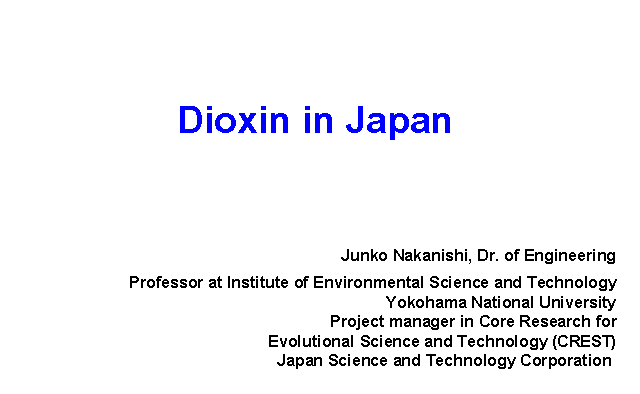
The research project was funded as a part of the Core Research for Evolutional Science and Technology (CREST) by the Japan Science and Technology Corporation under the jurisdiction of the Japan Agency of Science and Technology.
The subject of the project is the g Establishment of a scientific framework for the management of toxicity of chemicals based on environmental risk-benefit analysish. (OHP2)
OHP2

This project aims at providing Japanese society with a scientific basis for devising an environmental policy.(OHP3)
OHP3
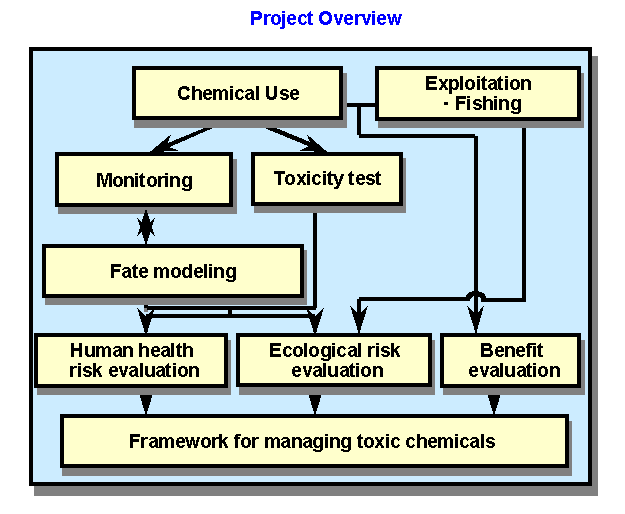
The framework of the project
is defined in the OHP sheet and consists of three major subjects:
1) to evaluate the human health risks from chemical use,
2) to evaluate the ecological risks from chemical use,
various type of exploitation and fishing, and
3) to balance the risks against the benefits of chemical
use. We are aiming at the development of a methodology for evaluating risks
and benefits, by carrying out some case studies of chemicals such as dioxins,
endocrine disrupting chemicals, DDT, benzene, mercury and indoor air pollutants.
I will now discuss the case study carried out on dioxins. Here, dioxins is referred to as polychlorinated dibenzodioxins (PCDDs) and polychlorinated dibenzofurans(PCDFs).
In 1997, the Ministry of Health and Welfare declared that large amounts of dioxins were being emitted from municipal garbage incinerators and it devised a policy to control their dioxins. Subsequent to this, reports that the dioxin pollution in Japan is incomparably severe were repeatedly conveyed day after day through mass media. Thus, generally, the Japanese people have the following common understanding of dioxin pollution.
1) There are as many as 2000 municipal garbage incinerators
in Japan and they emit large amounts of dioxins. ( I agree)
2) About 85 % of the total dioxins in Japan is emitted
from municipal garbage incinerators in Japan. ( I disagree)
3) Pollution due to dioxins is getting severer yearly,
because the amount of garbage incineration is also increasing. ( I disagree)
4) Atmospheric dioxin levels in large cities in Japan
are about ten times those in other developed countries. ( I agree)
5) Intake of dioxins of the average Japanese is three
to four times that in other developed countries. ( I disagree)
6) The dioxin level in breast milk is also more than
three times that in other developed countries. Breast-feeding may be dangerous.
( I disagree)
7) Human health risk due to dioxins does not fall within
the ordinarily acceptable limits. ( I disagree)
8) Residents living near garbage or industrial waste
incinerators are at the highest risk.
(I disagree)
In line with such a social background, the Ministry of Health and Welfare came up with a policy for abating dioxins. This includes the regulation program for dioxin levels in gas emitted from garbage incinerators and a policy that encourages the construction of large incinerators. The Ministry announced that only large incinerators, which incinerate more than 300 tons of garbage daily, and a minimum of 100 tons, would be subsidized.
I object to such a generalized understanding and to the Governmentfs policy regarding dioxin pollution prevention and have often voiced my opinion in newspapers and on television. In Japan, it is highly exceptional to oppose the general prevailing opinion as I have done.(OHP7)
OHP7
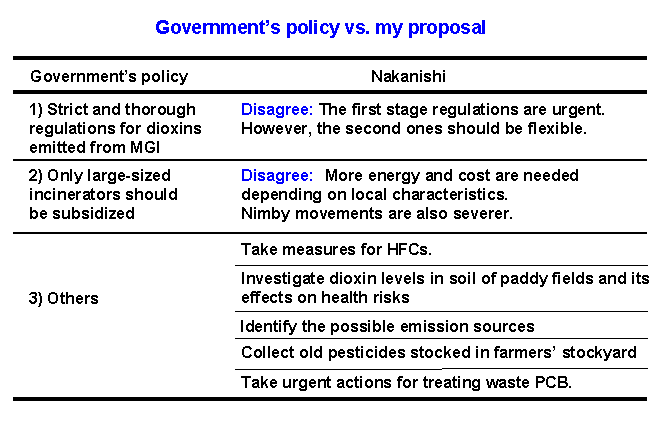
I will discuss these points now.
In Japan, the difference between a hazard and a risk
has not been well recognized. A hazard is defined as a source of possible
damage or injury, in other words a highly toxic chemical in this case.
There are no doubts that dioxins are hazards. However, dioxins do not always
pose great risks to humans. Risk is determined by two factors, toxicity
and exposure, and therefore, the magnitude of risk due to dioxins is not
significant when the exposure level is small.
The mass media have repeatedly covered dioxin pollution in a big way in the past two years. Their concern has always been the hazardous nature of dioxins. Therefore, they did not pay any attention to the risk due to dioxins. It is the information pertaining to risk or exposure pathways that is important to the public, though. Thus the above mentioned general understanding has been created. And the anxiety of the residents living near the garbage incinerators regarding their health has increased. In this context, some mothers made the decision not to breast-feed their children for fear of dioxins in breast milk. These misconceptions originate from an insufficient understanding of the risks due to dioxins.
Now, I will display some results of our investigation.@(OHPW)
OHP8
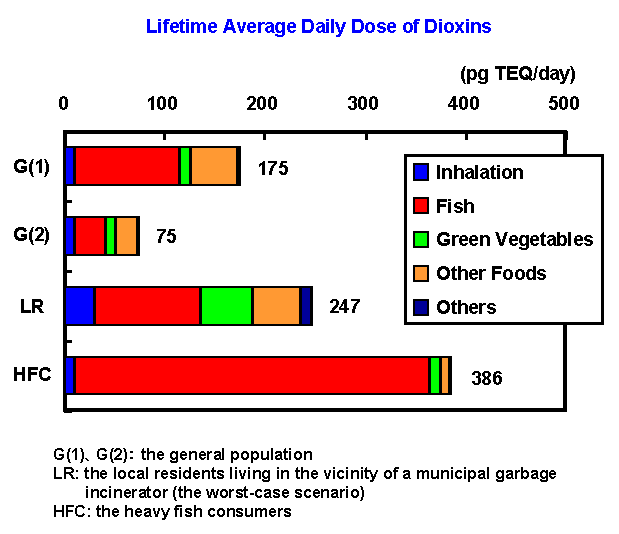
This OHP indicates the simulated magnitude of exposure for significant pathways for the general population, for residents near incinerators and for heavy fish consumers, which I published two years ago. Although I assumed two models for the general population in those days, we now know that the second moel, G(2), is more appropriate than G(1). The local residents (LRs) are defined as those who have lived within a 1000 m radius from a garbage incinerator emitting the highest level of dioxins and are exposed to the air and have consumed the green vegetables affected by emissions from the incinerator for thirty years.
This estimate refers to the theoretically worst-case scenario, and there is no such thing as a worst case. In even this case, the contribution of fish consumption is maximum and that from air is smaller. We should pay attention to the fact that a heavy fish consumer (HFC) is at more risk than an LR. In Japan, a certain percentage of people in fish-related businesses such as fishermen, fish mongers and sushi cooks, reportedly consume much more than the daily average. I refer to such people as HFC.
The next OHP shows the cancer risk estimates for the four groups@(OHP9). On the right, I drew the estimates of cancer risk due to chlorinated byproducts of tap water in Japan and in the United States in the 1980fs. The dioxin risk of the average Japanese should be reduced. However, it is not significantly higher than risks due to other chemicals which we encounter in our daily lives. Although we estimated the risks of other endpoints, including the adverse effects on fetuses, these are omitted here.
OHP9
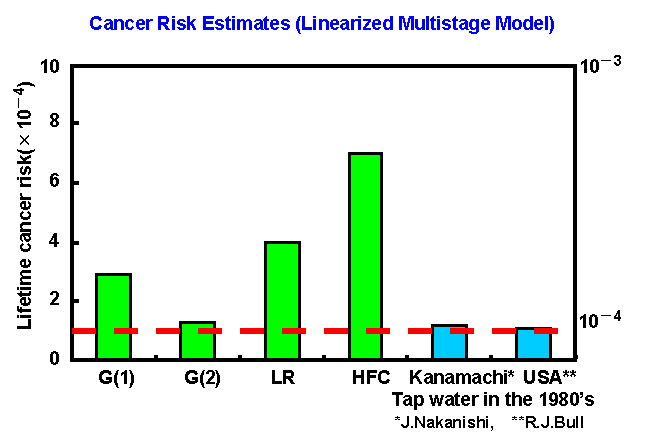
In order to reduce the dioxin risk, we must elucidate the emission sources of dioxins @and estimate their contribution. In the case of unintentionally produced substances, such as dioxins, this task is very hard. As we believe this to be a subject of utmost importance, we have been engaged in this work for a decade.
I will explain the method used for identifying the possible major origins of dioxins. As already known, a family of dioxins has numerous congeners. Targeting dioxins and furans with four or more chlorines, the number of congeners is 136. Among them, 17 are generally determined, because only 17 congeners are thought to be toxic and the others nontoxic. However, we have determined 87 of 136 congeners, because we thought we could obtain information about the origins of dioxins, based on the fact that the congener profile of dioxins is different depending on the origin.
These are examples of the results of the congener profile of the sediments of Tokyo Bay or sediments and soils at various sites@(OHP11). Please imagine this as the facial features of a child. Reading his facial features carefully, you can guess who his parents are. A similar method was used. Using the principal component analysis, we extracted four major components (OHP12).
OHP11
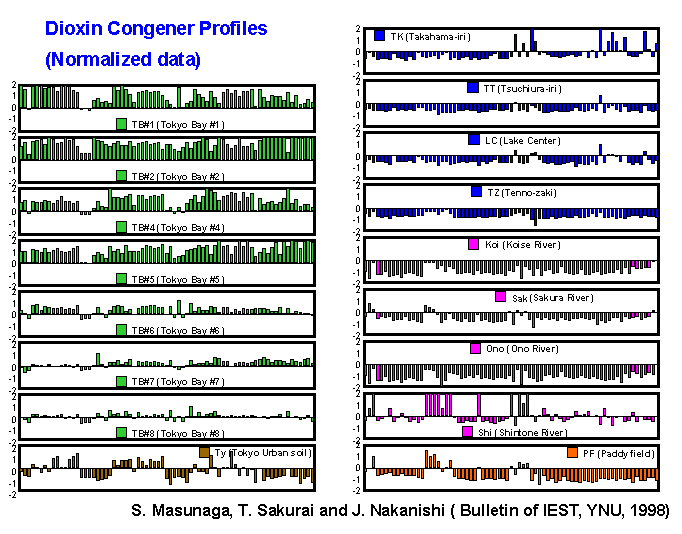
OHP12
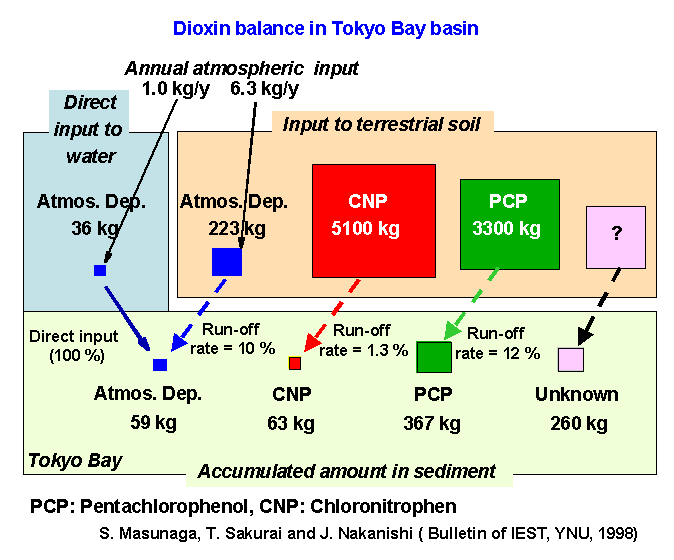
The first one was attributed to atmospheric deposition, the second to CNP, chloronitrophen, a herbicide for paddy fields, the third to PCP, pentachlorophenol, also a herbicide for paddy fields, and the fourth to an unknown component. The results were completely different from our expectations, and from the general belief.
The next film (OHP13) shows the trends of consumption of major herbicides in Japan. As seen, PCP was used in the 1960fs but its use for paddy fields was banned in 1972. CNP was used until recently, however, its peak was in the 1970fs. We were surprised at the fact that impurities of such outdated herbicides have still persisted in Tokyo Bay and their contribution is still significant. As this result was obtained with the aid of congener profiles of dioxins including nontoxic congeners, it does not directly indicate that both the herbicides contain the toxic dioxin congeners.
OHP13
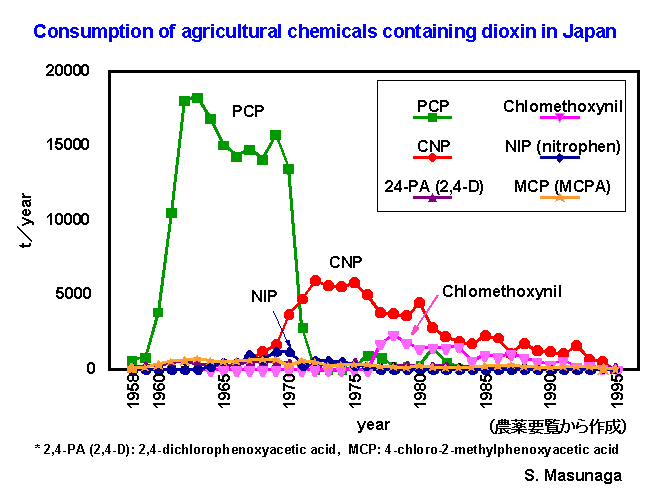
Nobody has published information regarding the detection of toxic congeners in both the herbicides manufactured in Japan. However, it has been thought that PCP might have toxic congeners, because PCP manufactured in foreign countries was known to contain toxic congeners. But many researchers had reported that no toxic congeners were contained in CNP, which was manufactured and used only in Japan.
We thought that we should examine dioxin impurities in the outdated herbicides. However, it was hard to obtain herbicides manufactured as long as forty or thirty years ago. When we had almost given up, a friend living in a rural area suggested I could look for them in farmersf stockyards. As he anticipated, we found various types of outdated herbicides and pesticides in farmersf stockyards in Ibaraki and Gunma Prefectures. This is a photo of a herbicide containing CNP found by us, which was manufactured in 1975. (OHP14)
OHP14
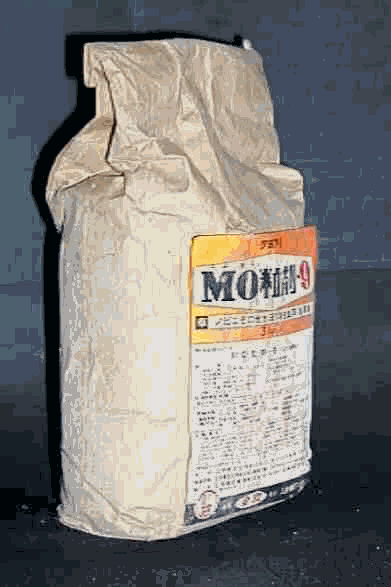
We revealed that high concentrations of toxic dioxins were contained in both the herbicides. As shown in the OHP (OHP15), the highest value for PCP was 14,000 I-TEQ ng/g (ppb) and 7,000 I-TEQ ng/g for CNP. Using the dioxin concentration and the consumed amount of both the herbicides, the dioxin emitted to the paddy fields was estimated for three and half decades (OHP16). The result is shown in this sheet. Considering the total amount of dioxin discharged into the environment over three and half decades, the contribution of the herbicides accounts for more than 80 %.
OHP15
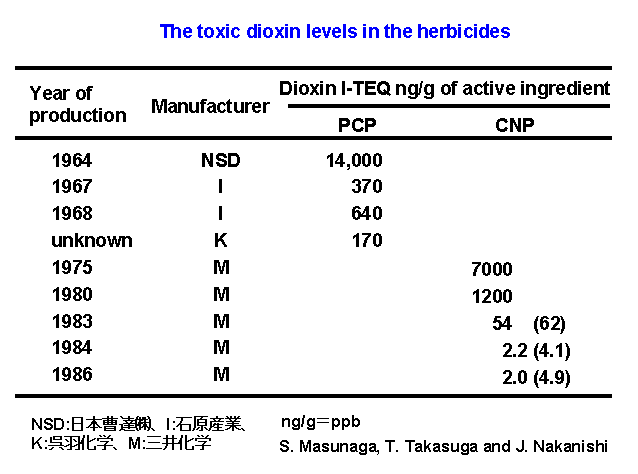
OHP16
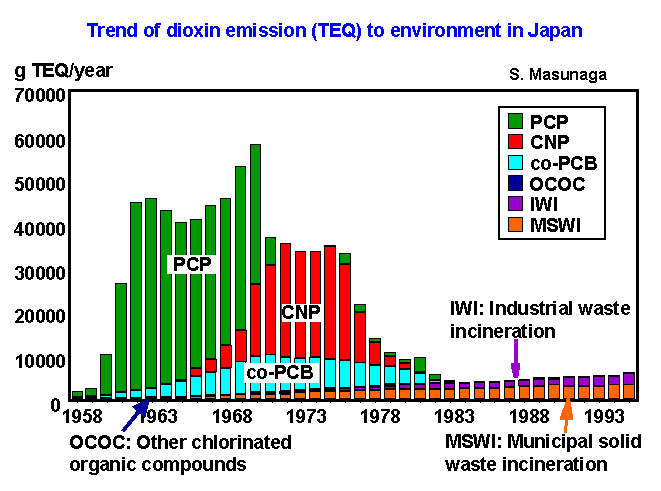
The next OHP (OHP17) indicates a chronological table of dioxin impurity contents in CNP and events about CNP and the Vietnam War. The use of CNP started in 1965, coincidentally in the same year when the US Air Force started bombing Northern Vietnam.
OHP17

We can observe that the dioxin contents in CNP markedly decreased after Agent Orange became a political and social issue.
The total amount of toxic dioxins in paddy fields is estimated to be 590 kg TEQ. This amount is comparable to or more than the amounts used in Vietnam by the US Air Force (OHP18). I must admit that these figures are rough estimates, though.
OHP18
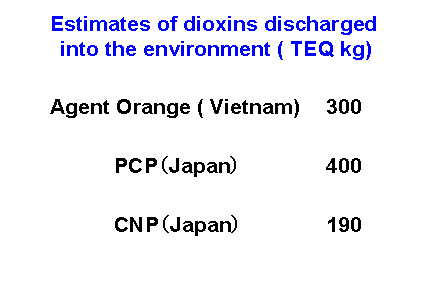
The rice acreage was three million ha in the 1970s. Assuming that 590 kg of dioxin was applied in the area, the average dioxin level in the soil of paddy fields is calculated to be about 100 pg/ g of soil (OHP19). According to the recent monitoring data by the EA, the average dioxin level in the soil of paddy fields was 51 (I-TEQ) pg/g.
OHP19
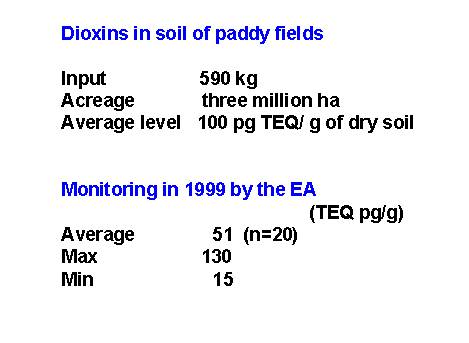
I thought that our results were so epochal that they would urge the Governmentfs policy to change. However, not only the mass media but also the Government paid no attention to the results. Besides this, we came under the attack of many parties: a representative of Mitsui Chemical Co., the manufacturer of herbicide CNP, stated it would file a suit against us, a high ranking officer of the Ministry of Agriculture, Forest and Fishery commented that our results are not reliable and also almost all the scientists in this field agreed with the viewpoints of Mitsui Chemical.
However, although at the beginning both Mitsui Chemical Co. and the Ministry of Agriculture, Forest and Fishery took a strong stand against our results, they suddenly changed their attitude in July. On July 8, Mitsui Chemical and the Ministry of Agriculture, Forest and Fishery gave separate press conferences at which they admitted that toxic congeners were contained in herbicide CNP.
The next OHP shows the yearly trends of dioxin levels in archived breast milk, analysis of which was conducted by Dr. Masatake Toyoda, at National Institute of Health Sciences (OHP20). This shows that dioxin levels in breast milk are decreasing yearly.
OHP20
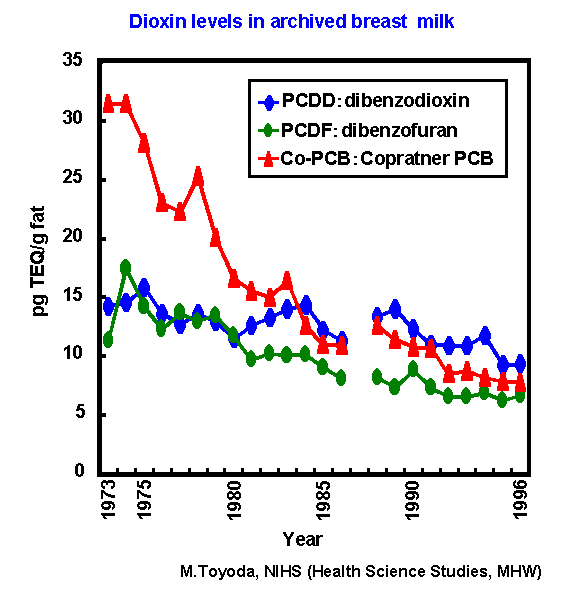
The next OHP shows the temporal trends of dioxin levels in archived diet samples which had been collected for the htotal diet studyh (OHP21). This too indicates the decreasing trends of dioxin in diet. These trends would not occur, if major dioxins originated from garbage incinerators. I think we must examine the state of dioxin pollution due to herbicide impurities and its effects on human health risks. In addition, we must recognize that the significant portion of dioxins is a hangover of the former times.
OHP21
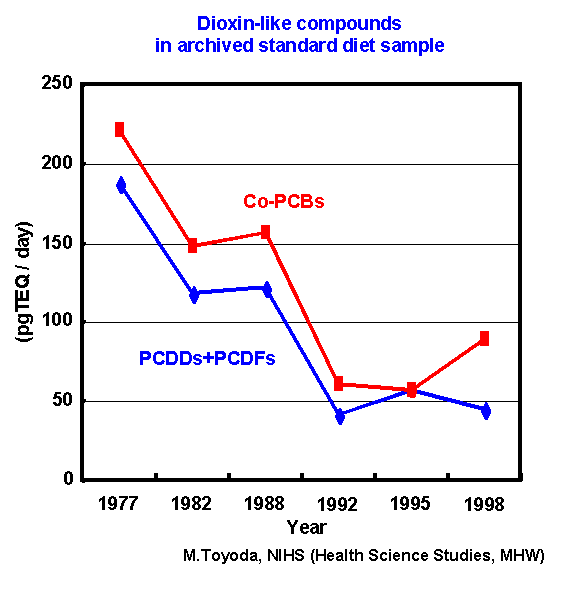
Until now, I have discussed dioxins which include dibenzodioxins and dibenzofurans. However, we must also consider the toxic effects due to coplanar polychlorinated biphenyls (Co-PCB) which are thought to have dioxin-like toxicity. PCB was manufactured in the 1960fs and used for transformer, condenser and reproduction paper and its use was banned in 1974 because of its persistency. Coplanar PCBs are congeners of PCB which have dioxin-like toxicity. In 1999, the Government decided torelable daily intake, TDI, of 200 pg/day for the TEQ values of the sum of dioxins and coplanar PCB. Henceforth, I will refer to dioxins and coplanar PCB as dioxin-like compounds.
The OHP (OHP 22) shows the result of the average Japanese intake of dioxin-like compounds, which was released this September. This is the first result on the intake of dioxin-like compounds including coplanar PCB. According to the result, the average Japanese dietary intake is about 100 TEQ pg/day which accounts for 91% of the total exposure. In addition, it is significant that coplanar PCB accounts for 60% of dioxin-like compounds in the diet. In addition, it indicates that the Japanese intake about 70 % of dioxin-like compounds in terms of TEQ via fish consumption. This reveals to us that we must undertake measures for reducing coplanar PCB. Well, how? What is the origin of coplanar PCB?
OHP22
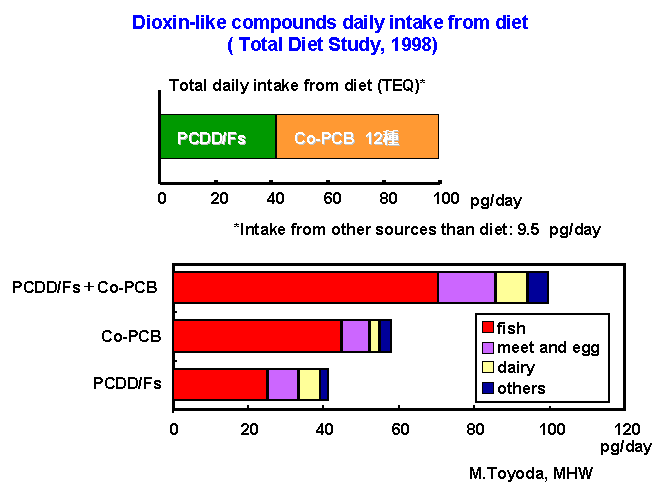
As I told above, the production
and use of PCB were prohibited in 1974.
The OHP 21 shows that the level of coplanar PCB in the
diet has decreased yearly. However, we cannot definitely say that this
PCB has come from that discharged in the past. The level of coplanar PCB
in the diet seems to have recently leveled off recently and there are many
reports that stocked waste PCB has been lost. Only 10 % of about 55,000
tons of PCB which was manufactured and used in Japan was treated and the
rest of them has been exposed to a risk of being lost for four decades.
In fact, a document of the MHW reported that 140 tons of PCB was lost in
the two decades.
As I mentioned earlier, by targeting the garbage incinerators, the Government is taking measures to abate levels of dioxin-like compounds, without investigating the origin of dioxins and coplanar PCB. For this purpose, vast sums of money are being invested in construction of new incinerators. I do not believe that this policy is effective in reducing the human health risk due to dioxin-like compounds. I would like to stress that it is of the utmost importance to identify the possible sources of dioxins and coplanar PCB. Certainly, we also must examine also about measures for reducing dioxin emission levels from garbage incinerators. Considering exposure levels and pathways, we must spend some more time before making a decision on which way to proceed in terms of garbage treatment.